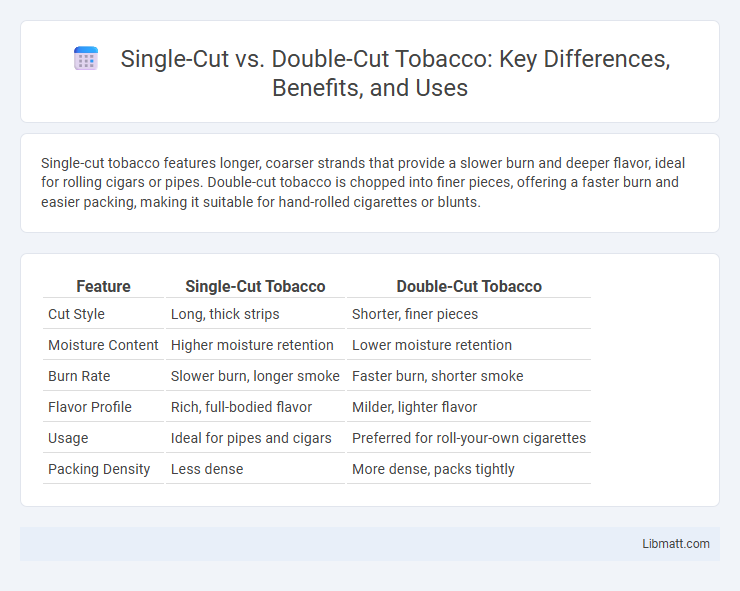Single-cut tobacco features longer, coarser strands that provide a slower burn and deeper flavor, ideal for rolling cigars or pipes. Double-cut tobacco is chopped into finer pieces, offering a faster burn and easier packing, making it suitable for hand-rolled cigarettes or blunts.
Table of Comparison
| Feature | Single-Cut Tobacco | Double-Cut Tobacco |
|---|---|---|
| Cut Style | Long, thick strips | Shorter, finer pieces |
| Moisture Content | Higher moisture retention | Lower moisture retention |
| Burn Rate | Slower burn, longer smoke | Faster burn, shorter smoke |
| Flavor Profile | Rich, full-bodied flavor | Milder, lighter flavor |
| Usage | Ideal for pipes and cigars | Preferred for roll-your-own cigarettes |
| Packing Density | Less dense | More dense, packs tightly |
Understanding Single-Cut vs Double-Cut Tobacco
Single-cut tobacco features longer, thicker strands that provide a slower burn and a cooler, smoother smoking experience, ideal for pipe smokers seeking a traditional feel. Double-cut tobacco is finely chopped, offering a faster burn and easier packing, which suits those who prefer a more consistent, robust flavor. Understanding these differences helps you choose the tobacco type that best matches your smoking style and preferences.
Historical Origins of Tobacco Cutting Techniques
Single-cut tobacco, characterized by longer, coarser leaves, traces its origins to early 17th-century American plantations where simplicity in processing matched traditional European consumption. Double-cut tobacco emerged later in the 19th century, featuring finer, more uniform cuts designed to enhance burning consistency and flavor release, aligning with evolving smoking technologies such as the rise of pipe smoking. Your understanding of these historical cutting techniques enriches appreciation of tobacco's cultural and manufacturing evolution.
Production Process: How Single-Cut Tobacco Is Made
Single-cut tobacco is produced by slicing cured tobacco leaves into long, wide strips, maintaining the leaf's broad surface for a thicker, more robust cut compared to double-cut tobacco. The production process involves curing the leaves through air or flue curing methods before passing them through cutting machines that produce these larger strips. This method results in tobacco that burns slower and packs denser, making it popular for rolling cigarettes and crafting cigars.
Double-Cut Tobacco: Methods and Distinct Characteristics
Double-cut tobacco undergoes a slicing process that produces longer, thicker strands compared to the thinner slices in single-cut, enhancing its burn duration and flavor release. The cutting technique involves passing tobacco leaves through specialized blades set at wider intervals, preserving essential oils and providing a coarser texture favored in pipe smoking. Your selection of double-cut tobacco can influence the smoking experience by offering a slower, cooler burn with richer, more complex aromas.
Flavor Profile Differences: Single-Cut vs Double-Cut
Single-cut tobacco features thicker, coarser strands that release a robust, full-bodied flavor with slower burning, enhancing your smoking experience with rich, earthy notes. Double-cut tobacco is finely shredded, producing a smoother, lighter smoke that highlights subtle, delicate flavors and provides a quicker burn. Your choice between single-cut and double-cut tobacco directly influences the intensity and complexity of the flavor profile delivered.
Smoking Experience: Draw, Burn Rate, and Aroma
Single-cut tobacco offers a slower burn rate and a cooler draw, enhancing the rich, natural aroma for a smoother smoking experience. Double-cut tobacco provides a looser packing density, resulting in an easier draw and a faster burn, which intensifies the flavor release but can reduce aroma subtlety. Choosing between single-cut and double-cut impacts your smoking satisfaction by balancing draw resistance, burn longevity, and aromatic complexity.
Moisture Retention and Freshness in Tobacco Cuts
Single-cut tobacco retains moisture better due to its thicker and longer strands, which help preserve freshness during storage, enhancing the smoking experience. Double-cut tobacco, with its finer and shorter strands, dries out more quickly but lights faster and burns more evenly. Your choice between single-cut and double-cut tobacco should consider how long you want to maintain moisture and freshness before use.
Suitability for Rolling Cigarettes and Pipes
Single-cut tobacco, characterized by coarser and longer strands, is ideal for hand-rolling cigarettes as it provides a slower burn and easier manipulation during rolling. Double-cut tobacco features finer, shorter strands, making it better suited for pipes due to its even packing and consistent burn. Rollers seeking a more natural, traditional cigarette experience often prefer single-cut, while pipe smokers favor double-cut for optimal packing and flavor release.
Consumer Preferences and Market Trends
Consumer preferences for single-cut tobacco often emphasize a coarser texture that burns slower, appealing to traditional pipe and roll-your-own smokers seeking a robust flavor and longer smoking experience. Double-cut tobacco, with its finer, more uniform pieces, caters to users favoring convenience, consistent packing, and quicker ignition, driving increased demand in markets focused on ready-to-use products. Market trends indicate a growing shift toward double-cut tobacco in regions with rising urban populations and fast-paced lifestyles, while single-cut maintains steady loyalty among purists and premium tobacco segments.
Choosing the Right Cut: Which Is Better for You?
Single-cut tobacco offers longer strands that burn slower and provide a smoother smoking experience, making it ideal for those who prefer a mild and leisurely smoke. Double-cut tobacco features shorter strands that pack more densely, resulting in a faster, more intense burn suited for smokers seeking a stronger, more robust flavor. Your choice depends on whether you value a relaxed, gradual draw or a bold, quicker smoke.
single-cut tobacco vs double-cut Infographic

 libmatt.com
libmatt.com